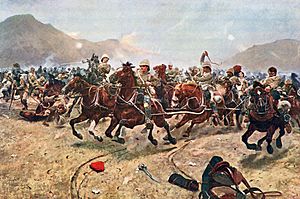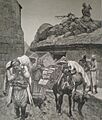Richard Caton Woodville Jr. facts for kids
Quick facts for kids
Richard Caton Woodville
|
|
|---|---|
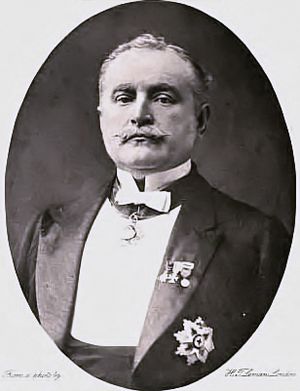 |
|
| Born | 7 January 1856 London, England
|
| Died | 17 August 1927 (aged 71) London, England
|
| Nationality | British |
| Education | Düsseldorf school of painting |
| Known for | portrait, landscape, illustration, battle painting |
| Patron(s) | Illustrated London News |
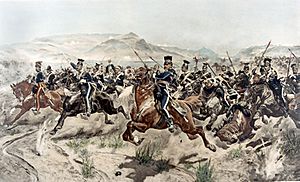
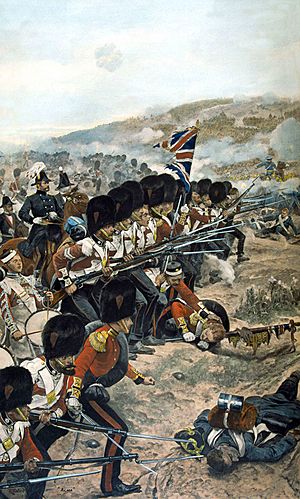
Richard Caton Woodville Jr. RI ROI (born January 7, 1856 – died August 17, 1927) was a talented English artist and illustrator. He is most famous for painting many exciting and detailed battle scenes. He created these works in the late 1800s and early 1900s.
Contents
About Richard Caton Woodville Jr.
Early Life and Training
Richard Caton Woodville Jr. was the son of another skilled artist, Richard Caton Woodville Sr. Young Richard studied art in Germany at the Düsseldorf school of painting. His teachers included Wilhelm Camphausen, who was a military artist, and Eduard von Gebhardt. After that, he briefly studied in Russia and then in Paris with Jean-Léon Gérôme.
Working as an Illustrator
Woodville spent most of his career working for the Illustrated London News. This was a very popular newspaper that showed pictures of news events. He quickly became known as a great reporter and writer there. His work also appeared in other magazines like Cornhill Magazine, Strand Magazine, and The Tatler.
Experiencing Battle First-Hand
Richard Caton Woodville got to see battles up close. The Illustrated London News sent him to report on the Russo-Turkish War (1877–1878). Later, he went to the 1882 Anglo-Egyptian War. There, he drew many sketches in December 1882. He also took photos of the trenches for his artist friend, Alphonse-Marie-Adolphe de Neuville. His friend was painting a scene from that battle.
Famous Battle Paintings
In 1879, Woodville's painting Before Leuthen, 3 December 1757 was shown at the Royal Academy of Arts. People really liked it. After this, his paintings were often shown at Burlington House. In total, 21 of his battle paintings were displayed there.
His most popular paintings showed recent wars. These included the Second Anglo-Afghan War, with works like Candahar and Maiwand: Saving the Guns. He also painted scenes from the Anglo-Zulu War and the First Boer War.
In 1883, his paintings from Egypt were shown at the Fine Art Society. His painting The Moonlight Charge at Kassassin was very popular. The next year, he showed another painting from the war in Egypt, called The Guards at Tel-e-Kebir. This painting was even requested by the Royal Family. In 1896, he designed the back of the British South Africa Company Medal.
Later Works and World War I
Woodville kept painting battle scenes throughout his life. He painted almost every war that Great Britain fought during his time. This included the Second Boer War and World War I.
Even though he was great at showing modern battles, Woodville also loved to paint historical scenes. He used both oil paints and watercolors. The Illustrated London News asked him to create a special series. This series would show the most famous British battles in history. He painted The Charge of the Light Brigade and The Charge of the 21st Lancers at Omdurman. He also painted scenes from the Battle of Blenheim, Battle of Badajos, and several pictures of the Battle of Waterloo.
During World War I, Woodville had to paint current events again. Three of his World War I paintings were shown at the Royal Academy of Arts. These were The 2nd Batt. Manchester Regiment taking six guns at dawn near St. Quentin, Entry of the 5th Lancers into Mons, and Halloween, 1914: Stand of the London Scottish on Messines Ridge. The last one was shown in 1927, the year he passed away.
Personal Life and Challenges
During his life, Woodville was very popular. Many people thought he was the best artist of his kind. He also wrote articles and was often featured in magazines. He loved the British Army very much. He even joined the Berkshire Yeomanry in 1879 and stayed until 1914. Then, he joined the National Reserve as a Captain.
He married Annie Elizabeth Hill in 1877. They had twin sons in 1884: Anthony Caton Woodville, who became an actor, and William Passenham Caton Woodville, who became a painter. His wife later divorced him in 1892. Despite his success, Caton Woodville faced financial difficulties and was declared bankrupt in 1905.
Death and Legacy
Richard Caton Woodville died on August 17, 1927, at his art studio in St John's Wood. He was not wealthy when he died. Because of this, his grave was not marked at the time. In September 2013, his great-grandson arranged for a headstone to be placed on his grave.
Today, you can still see Richard Caton Woodville's paintings. They are displayed in important places like the National Army Museum, the Tate, the Walker Art Gallery, and the Royal Academy.
Selected Paintings (by date)
- Before Leuthen, 3 December 1757 (1879)
- Turkish Reconnoitring Party in Balkans (Russo-Turkish War) (1878)
- Candahar: The 92nd Highlanders & 2nd Goorkhas storming Gaudi Mullah Sahabdad (1881)
- Cruel To Be Kind (1882 – National Army Museum)
- The Moonlight Charge at Kassassin (1883)
- Maiwand: Saving the Guns (1883 – Walker Art Gallery)
- In the Nick of Time (1883)
- The Guards at Tel-e-Kebir (1885 – Royal Collection)
- The Late Commander Wyatt-Rawson, R.N., killed at Tel-el-Kebir, 13 September 1882 (1885 – Royal Naval College, Greenwich)
- The Charge of the Light Brigade (1894 – Palacio Real de Madrid)
- Waterloo: The Old Guard (Palacio Real de Madrid)
- The Storming of the Great Redoubt at the Battle of the Alma (1896 – Coldstream Guards)
- The Relief of the Light Brigade (1897 – National Army Museum)
- A Gentleman in Khaki (1899)
- Life Guards charging at the Battle of Waterloo (1899)
- Gordon's Memorial Service at His Ruined Palace in Khartoum, the Day after The Battle of Omdurman (1899 – Royal Collection)
- The Dawn of Majuba (1900 – The Royal Canadian Regiment Museum, London, Ontario)
- French Hussards fording a River (1901)
- Lindlay: Whitsunday, 1900 (Church service on the veldt) (1901 – 5th Battalion, Royal Green Jackets, Oxford)
- All that was left of them (1902 – 17th/21st Lancers Museum, Belvoir Castle)
- Scotland Yet! On to Victory (Scots Greys at Waterloo) (1904 – Royal Scots Dragoon Guards)
- At the Trumpet's Call (Marston Moor) (1904)
- General Wolfe Climbing the Heights of Abraham on the Morning of the Battle of Quebec (1906 – Tate)
- The Returning Orderly (1908 – Williamson Art Gallery, Birkenhead)
- Napoleon before Wagram (1909)
- Sic Transit Gloria Mundi (Retreat from Moscow) (1911)
- Napoleon Crossing the Bridge to Lobau Island (1912 – Tate)
- Poniatowski's Last Charge at Leipzig (1912 – Tate)
- Napoleon conferring the Legion D'Honneur on a Russian General, 1804 (1912)
- Drawn Sabres: Napoleon's Guards at the Battle of Wagram (West Point)
- A Narrow Shave! Dragoon in Napoleon's Army 1810
- Marshal Ney at Eylau (1913 – Tate)
- The First VC of the European War (1914 – National Army Museum)
- The Last Call (Trumpeter falling at Charge of Light Brigade) (1915 – The Queen's Royal Hussars)
- The Piper of Loos (King's Own Scottish Borderers Regimental Association)
- The Battle of the Somme (1917 – Guards Museum)
- The 2nd Batt. Manchester Regiment taking six guns at dawn near St. Quentin (1918 – Duke of Lancaster's Regiment)
- Entry of the 5th Lancers into Mons (1919 – Queen's Royal Lancers)
- The Charge of the 9th Lancers at Moncel, 7 September 1914 (1921 – 9th Queen's Royal Lancers)
- Halloween, 1914: Stand of the London Scottish on Messines Ridge (1927 – London Scottish Regiment Museum Trust)
Other Paintings
- Ascending The Great Pyramid
- Tyrol – Turning The Great Corner
- Burma – Minister of State With Attendants
- Bull-Fighting
- Trades – Estate Agent 'Sold'
- Fishing For Bass on the South Coast of England
- London – Hyde Park in the Row
- Lost Their Way
Images for kids
- Woodville, Richard Caton. Random Recollections (1914) London: Eveleigh Nash.
- Roger T. Stearn, ‘Woodville, Richard Caton (1856–1927)’, Oxford Dictionary of National Biography, Oxford University Press, 2004. Retrieved 2 January 2008
- – with some mis-attribution to the father of work by the son (for attributions to the son, see above)


